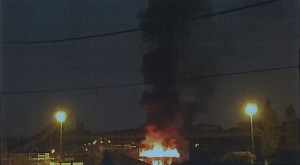In a tyre manufacturing plant at around 5:00 a.m., during the process to lock-out a 20 kV cell for maintenance, a fire broke out in a 20,000 V electrical substation near a 63,000 V transformer. The technician who removed the lock-out key noticed a light at the bottom of the cell and heard a loud crackling sound. The foreman ordered the 3 workmen to leave the premises. As they left the building, they heard a loud explosion. High flames erupted, followed by a significant release of smoke. The internal contingency plan was initiated at 06:02 a.m. Once the Very High Voltage power supply was switched off, the plant’s internal emergency services were able to extinguish the fire at around 6:40 a.m.
The incident affected the power supply to several of the company’s facilities and part of the stadium located nearby. Property damage was extensive: Twelve 20 kV cells and other equipment within the premises were destroyed, the equipment in the neighbouring room was severely damaged, particularly the 3 kV cells. One of the four 63/20 kV transformers was destroyed by overcurrent, although the others had been protected by a firewall. The mould-making and mixing workshops were shut down for 2.5 days. The environmental consequences were limited, and less than 3 kg of sulphur hexafluoride were released, in addition to the soot and fumes from the fire.
The condition of the equipment did not allow the causes of the accident to be determined precisely. However, based on the analysis conducted by the operator, the start of the fire appears to point to 3 causes: the presence of unintentional current when the lock-out key was removed, a short circuit on one or more obsolete cables in a humid atmosphere and a safety device malfunction.
The operator took the following measures:
- strengthening of the validation of the lock-out procedures;
- continued specialisation of HV technicians;
- additional training for younger employees on the older technologies;
- familiarisation of the technicians with appropriate actions in the event of an outbreak of fire on an HV switchboard;
- increased frequency of preventive maintenance operations.




